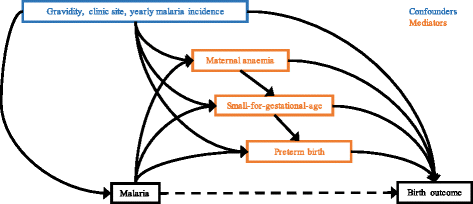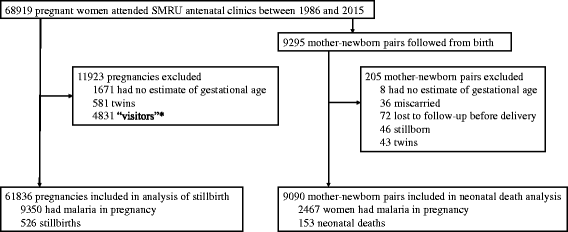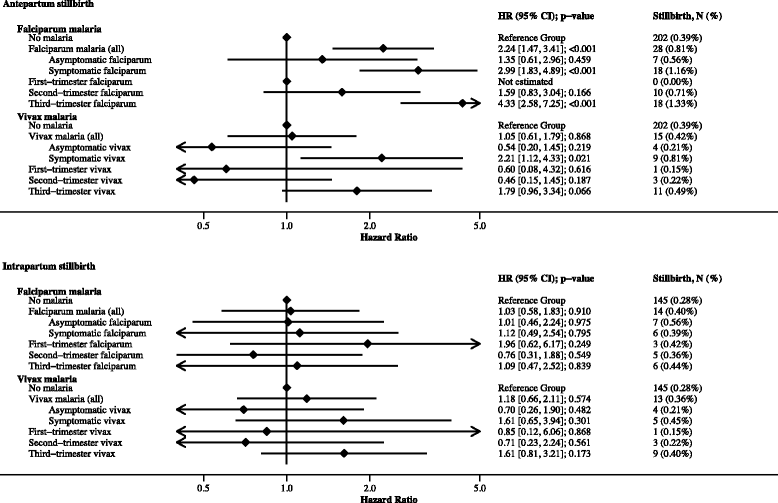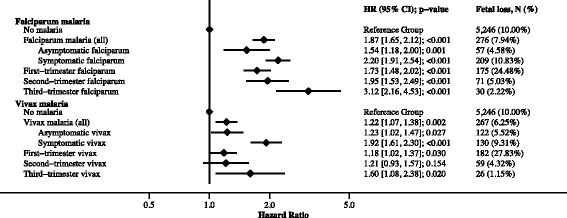Mediation of the effect of malaria in pregnancy on stillbirth and neonatal death in an area of low transmission: observational data analysis
- PMID: 28486979
- PMCID: PMC5424335
- DOI: 10.1186/s12916-017-0863-z
Mediation of the effect of malaria in pregnancy on stillbirth and neonatal death in an area of low transmission: observational data analysis
Abstract
Background: Malaria in pregnancy is preventable and contributes significantly to the estimated 5.5 million stillbirths and neonatal deaths that occur annually. The contribution of malaria in pregnancy in areas of low transmission has not been quantified, and the roles of maternal anaemia, small-for-gestational-age status, and preterm birth in mediating the effect of malaria in pregnancy on stillbirth and neonatal death are poorly elucidated.
Methods: We analysed observational data routinely collected at antenatal clinics on the Thai-Myanmar border (1986-2015). We used Cox regression and sequential mediation analysis to determine the effect of falciparum and vivax malaria in pregnancy on antepartum (death in utero) and intrapartum (death during labour) stillbirth and neonatal mortality as well as mediation through maternal anaemia, preterm birth, and small-for-gestational-age status.
Results: Of 61,836 women, 9350 (15%) had malaria in pregnancy, and 526 (0.8%) had stillbirths. In a sub-set of 9090 live born singletons followed from birth there were 153 (1.7%) neonatal deaths. The hazard of antepartum stillbirth increased 2.24-fold [95% confidence interval: 1.47, 3.41] following falciparum malaria (42% mediated through small-for-gestational-age status and anaemia), driven by symptomatic falciparum malaria (hazard ratio, HR: 2.99 [1.83, 4.89]) rather than asymptomatic falciparum malaria (HR: 1.35 [0.61, 2.96]). The hazard of antepartum stillbirth increased 2.21-fold [1.12, 4.33] following symptomatic vivax malaria (24% mediated through small-for-gestational-age status and anaemia) but not asymptomatic vivax malaria (HR: 0.54 [0.20, 1.45]). There was no association between falciparum or vivax malaria in pregnancy and intrapartum stillbirth (falciparum HR: 1.03 [0.58, 1.83]; vivax HR: 1.18 [0.66, 2.11]). Falciparum and vivax malaria in pregnancy increased the hazard of neonatal death 2.55-fold [1.54, 4.22] and 1.98-fold [1.10, 3.57], respectively (40% and 50%, respectively, mediated through small-for-gestational-age status and preterm birth).
Conclusions: Prevention of malaria in pregnancy, new and existing interventions to prevent small-for-gestational-age status and maternal anaemia, and improved capacity for managing preterm and small-for-gestational-age newborns will reduce the number of malaria-associated stillbirths and neonatal deaths in malaria-endemic areas.
Keywords: Malaria in pregnancy; Mediation analysis; Neonatal death; Stillbirth.
Figures




Similar articles
-
Influence of the number and timing of malaria episodes during pregnancy on prematurity and small-for-gestational-age in an area of low transmission.BMC Med. 2017 Jun 21;15(1):117. doi: 10.1186/s12916-017-0877-6. BMC Med. 2017. PMID: 28633672 Free PMC article.
-
Effects of Plasmodium vivax malaria in pregnancy.Lancet. 1999 Aug 14;354(9178):546-9. doi: 10.1016/s0140-6736(98)09247-2. Lancet. 1999. PMID: 10470698
-
Rate, determinants, and causes of stillbirth in Jordan: Findings from the Jordan Stillbirth and Neonatal Deaths Surveillance (JSANDS) system.BMC Pregnancy Childbirth. 2020 Sep 29;20(1):571. doi: 10.1186/s12884-020-03267-2. BMC Pregnancy Childbirth. 2020. PMID: 32993562 Free PMC article.
-
Epidemiology and burden of malaria in pregnancy.Lancet Infect Dis. 2007 Feb;7(2):93-104. doi: 10.1016/S1473-3099(07)70021-X. Lancet Infect Dis. 2007. PMID: 17251080 Review.
-
Cesarean section on request at 39 weeks: impact on shoulder dystocia, fetal trauma, neonatal encephalopathy, and intrauterine fetal demise.Semin Perinatol. 2006 Oct;30(5):276-87. doi: 10.1053/j.semperi.2006.07.009. Semin Perinatol. 2006. PMID: 17011400 Review.
Cited by
-
Peripheral Plasmodium falciparum Infection in Early Pregnancy Is Associated With Increased Maternal Microchimerism in the Offspring.J Infect Dis. 2021 Dec 15;224(12):2105-2112. doi: 10.1093/infdis/jiab275. J Infect Dis. 2021. PMID: 34010401 Free PMC article.
-
Piperaquine Exposure Is Altered by Pregnancy, HIV, and Nutritional Status in Ugandan Women.Antimicrob Agents Chemother. 2020 Nov 17;64(12):e01013-20. doi: 10.1128/AAC.01013-20. Print 2020 Nov 17. Antimicrob Agents Chemother. 2020. PMID: 33020153 Free PMC article.
-
Isolation and Functions of Extracellular Vesicles Derived from Parasites: The Promise of a New Era in Immunotherapy, Vaccination, and Diagnosis.Int J Nanomedicine. 2020 Apr 28;15:2957-2969. doi: 10.2147/IJN.S250993. eCollection 2020. Int J Nanomedicine. 2020. PMID: 32425527 Free PMC article. Review.
-
Spatial distribution and determinants of intermittent preventive treatment for malaria during pregnancy: a secondary data analysis of the 2019 Ghana malaria indicators survey.BMC Pregnancy Childbirth. 2024 May 20;24(1):379. doi: 10.1186/s12884-024-06566-0. BMC Pregnancy Childbirth. 2024. PMID: 38769513 Free PMC article.
-
Placental Parasitic Infections and Pregnancy Outcomes Among Women Delivering at a Tertiary Hospital in Northern Tanzania.East Afr Health Res J. 2022;6(2):141-146. doi: 10.24248/eahrj.v6i2.695. Epub 2022 Nov 30. East Afr Health Res J. 2022. PMID: 36751683 Free PMC article.
References
-
- Blencowe H, Cousens S, Jassir FB, Say L, Chou D, Mathers C, et al. National, regional, and worldwide estimates of stillbirth rates in 2009 with trends since 1995: A systematic analysis. Lancet. 2016;377(9774):1319–30. - PubMed
-
- UN Inter-agency Group for Child Mortality Estimation . Levels and trends in child mortality: Report 2013. New York: UN Inter-agency Group for Child Mortality Estimation; 2013.
MeSH terms
Grants and funding
LinkOut - more resources
Full Text Sources
Other Literature Sources
Medical

